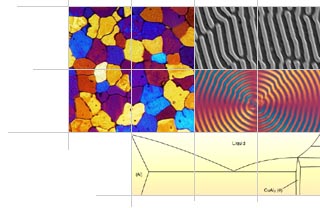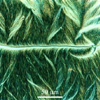Micrograph Library
Browse the libraryAdvanced searchSystemsCompositionsTechniquesKeywordsPhase diagramsHelpPreferencesAbout the micrograph libraryTerms of useContribute micrographs!FeedbackLinksCredits Print this page

Full Record for Micrograph 566
- Micrograph no
- 566
- Brief description
- Inversion wall revealed by spontaneous band texture in a liquid crystalline polymer
- Keywords
- alignment, disclination, dislocation
 , liquid crystalline polymer (LCP), nematic, polymer
, liquid crystalline polymer (LCP), nematic, polymer  , spontaneous band texture, texture
, spontaneous band texture, texture - Categories
- Polymer
- System
- Liquid crystalline polymer
- Composition
- Rigid copolyester of hydroxybenzoate (HBA) and hydroxynapthoate (HNA) (1:1)
- Standard codes
- Reaction
- Processing
- The band texture forms spontaneously during the solidification of nematic melts of some semi-flexible polymers. It may also be induced by shear
- Applications
- The molecules in a LCP mesophase can be steered by external fields; a property used in display technology. Alignment is also exploited in high strength fibres like Kevlar and mouldable Vectra
- Sample preparation
- Technique
- Cross-polarised light microscopy
- Length bar
- 50 μm
- Further information
- Above their melting point, liquid crystalline polymers exhibit a mesophase within which, although able to flow and are not arranged in a crystal, they exhibit long range orientational order. This ordering manifests itself in optical birefringence when viewed between crossed polars. Some show an optical band structure which reflects the local alignemnt of zig-zag chain bundles. The band texture forms spontaneously during the solidification of nematic melts of some semi-flexible polymers. It may also be induced by shear. The average chain direction is perpendicular to the long axes of the bands, and hence, the 'director field' (direction of local alignment) can be deduced directly from the orientation of the bands observed under an optical microscope, providing a shortcut to investigating the microstructure of thermotropic liquid crystalline polymers. In particular, the structures of various wedge disclinations and inversion walls can be revealed. These are defects in alignment, analogous to dislocations in a crystal. In this case, the texture of a rigid copolyester of hydroxybenzoate (HBA) and hydroxynapthoate (HNA) (1:1) reveals an inversion wall.
- Contributor
- Dr W Song
- Organisation
- Department of Materials Science and Metallurgy, University of Cambridge
- Date
- 03/10/02
- Licence for re-use
 DoITPoMS standard terms of use
DoITPoMS standard terms of use- Related micrographs


